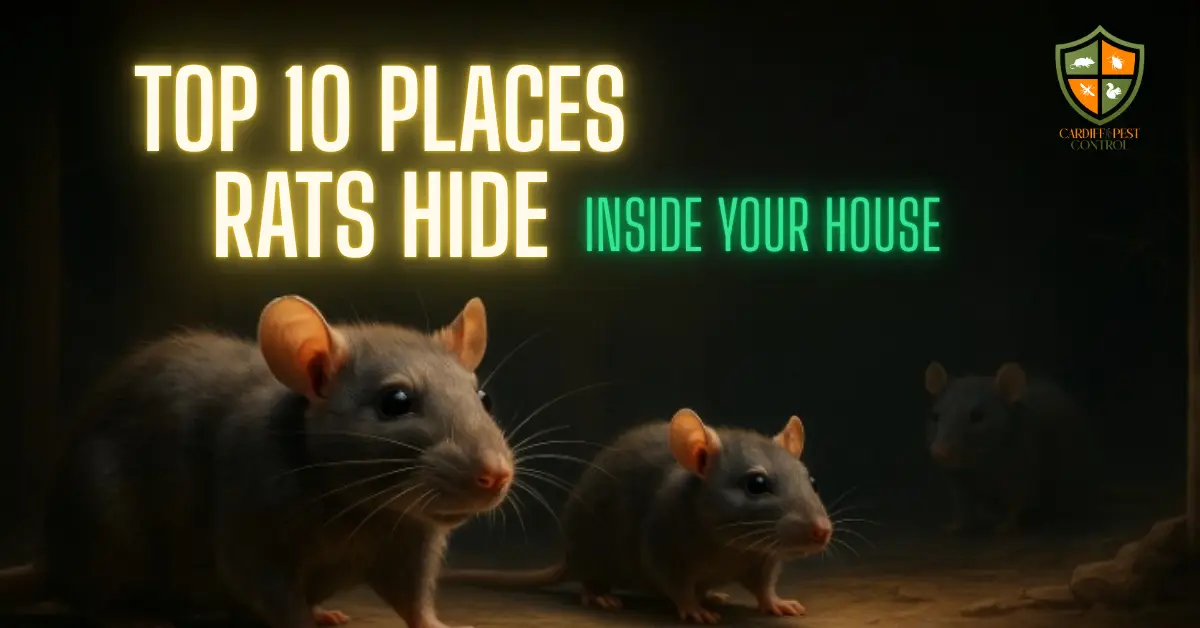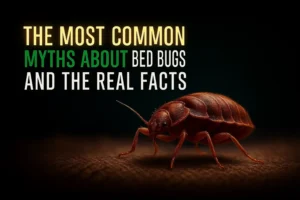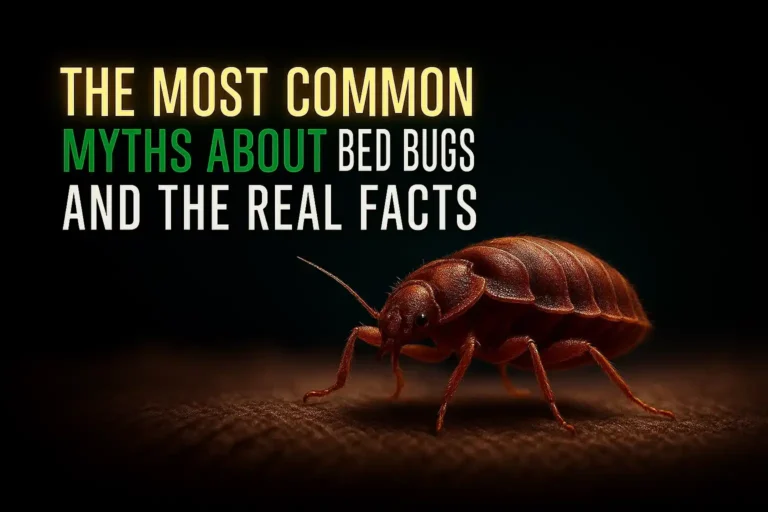Table of Contents
ToggleRats are among the most persistent pests that can invade your home. Once they find a way in, they rarely leave on their own. They settle into dark, quiet, and undisturbed spaces, slowly building nests, contaminating surfaces, and damaging your property from within. The most alarming part? They often go unnoticed until the damage is already done.
In this blog we will explore the top 10 places rats hide inside your house, helping you identify potential hiding spots, signs of rat activity, and practical ways to deal with them.
1. Behind Walls and Inside Ceilings
One of the most common places rats hide is behind your walls or inside ceiling cavities. These spaces offer everything a rat could need: warmth, safety, and insulation material for nesting. Most homeowners only realize the problem when they hear scratching sounds or notice odd smells.
Rats can access these spaces through small cracks, plumbing gaps, electrical outlets, or even through your attic. Once inside, they chew on wood, insulation, and even wiring, creating a fire hazard. Over time, the smell of urine and droppings may become noticeable.
Signs rats are hiding in walls or ceilings:
- Scratching or rustling noises, especially at night
- Chewed or gnawed drywall and wood
- A strong ammonia-like odor (rat urine)
- Electrical malfunctions caused by chewed wires
Behind-wall infestations are dangerous because they’re often hidden from view. These areas should be one of the first places you inspect if you suspect rodents.
2. Deep Inside Attics and Lofts
Attics and lofts provide the perfect shelter for rats. These areas are typically quiet, dark, and filled with soft materials like insulation, which rats use to build nests. If you store cardboard boxes, clothing, or holiday decorations in your attic, rats may chew through these for nesting material or shelter.
Rats often enter the attic through damaged roof tiles, vents, or nearby tree branches. Once inside, they reproduce quickly, and their presence may go unnoticed for weeks.
What makes attics ideal for rats:
- Little human activity
- Accessible via rooftops or trees
- Warm air and insulation to nest in
- Ample nesting materials from stored items
Inspect your attic for droppings, gnawed wood or cardboard, and shredded insulation. If you hear movement in the ceiling at night, you may have rats in the attic.
3. Quiet Corners of the Basement
Basements are another favorite hiding place for rats, especially unfinished or cluttered ones. They often enter through foundation cracks, window wells, or sump pump openings. Basements provide a consistent temperature, nearby water sources, and a low level of human activity.
Once inside, rats will hide behind stored boxes, near water heaters, or even burrow into insulation or drywall. Because basements are usually darker and used less often, rats can remain hidden for long periods.
Watch for these signs in your basement:
- Chewed or gnawed cardboard, cloth, or plastic
- Droppings around appliances or corners
- Shredded nesting material in boxes
- Unusual odor or stains on floors and walls
If your basement is cluttered or used as a storage space, it’s essential to regularly inspect it for signs of a rat infestation.
4. Under Kitchen Appliances and Cabinets
Rats seek food and water to survive, making your kitchen one of the most attractive areas in your home. They often hide under or behind major appliances such as stoves, refrigerators, and dishwashers. Lower kitchen cabinets, especially those under the sink, also attract rats due to moisture and food scraps.
In these spots, rats can nest, chew wiring, and even contaminate your food supply. It’s not uncommon to find droppings or gnawed packaging in pantry areas.
How to know if rats are in your kitchen:
- Droppings behind or under appliances
- Chewed plastic, wood, or food containers
- Nests made from paper towels, fabric, or insulation
- Scratching noises at night from cabinets or walls
Keeping your kitchen clean, storing food in airtight containers, and fixing leaks can help prevent rats from turning it into their hideout.
5. Inside Garages and Storage Boxes
Garages are often overlooked when inspecting rats. With access to storage boxes, insulation, old furniture, and even garbage bins, garages offer rats everything they need to survive. Gaps in garage doors, walls, or vents provide easy access, especially in older homes.
Rats will often settle in storage boxes, behind shelves, or near water heaters or laundry machines located in the garage. Once they’re comfortable, they may begin to explore the rest of your home.
Typical hiding areas in garages:
- Inside cardboard boxes or bags
- Behind large appliances or stored items
- Near pet food or trash bins
- Along garage walls or behind insulation
Switching to plastic bins for storage, sealing cracks, and reducing clutter are effective ways to keep rats out of your garage.
6. Behind Water Heaters and Laundry Units
Warmth and water are two of the biggest attractions for rats. That’s why they often hide behind water heaters, boilers, and laundry units. These areas are usually tucked into utility rooms or basements, out of sight from everyday traffic.
Rats hiding here can chew on hoses, cords, or even build nests near heat sources. These locations may also have water leaks, offering rats easy hydration.
Indicators of rat activity near water heaters:
- Droppings or greasy marks on the floor
- Chewed rubber or plastic hoses
- Sounds of movement when the area is quiet
Checking these utility areas regularly can prevent rats from nesting near these warm and moist spots.
7. Inside Drains, Pipes, and Sewer Lines
Rats can enter your home through broken sewer lines or uncovered drains. Once inside your plumbing system, they can access kitchens, bathrooms, and basements with ease. Some species, like the Norway rat, are known to be excellent swimmers, making sewers an easy access route.
Clues rats are entering through pipes:
- Bad odors from sinks or drains
- Scratching sounds near plumbing
- Unexplained droppings around floor drains
- Gurgling sounds in toilets or sinks
Installing backflow valves and covering drains with metal grates can help prevent rats from entering this way.
8. In Garden Sheds and Outdoor Storage
Rats don’t always start inside your home. Often, they take shelter in outdoor structures like sheds, then migrate indoors when the weather cools. Sheds, greenhouses, and outdoor storage containers often go weeks or months without being checked, giving rats a safe place to settle in.
If food, birdseed, or pet food is stored here, it will attract rats even faster. They may also burrow underneath sheds and find cracks that lead into the main house.
Places to inspect in and around sheds:
- Inside toolboxes, bags, or containers
- Under floorboards or garden beds
- Behind cluttered walls or stored equipment
- Holes along the base of the shed
Keeping sheds clean, sealed, and clutter-free is key to stopping rats before they enter your home.
9. Inside Furniture and Upholstery
Old furniture, especially in storage or unused rooms, provides excellent nesting material for rats. Sofas, chairs, and mattresses with fabric or foam padding allow rats to burrow and hide deep inside.
You may not notice the problem until furniture is moved or you find a shredded cushion. In some cases, rats can chew their way into drawers or upholstered bed frames.
Signs rats are inside furniture:
- Torn fabric or exposed stuffing
- Small entry holes near cushions or seams
- Rustling or squeaking sounds when furniture is moved
- Foul odor or droppings inside or under furniture
If you’ve stored old furniture in the garage, basement, or attic, inspect it thoroughly before bringing it back into your living spaces.
10. Crawl Spaces and Under Floorboards
Crawl spaces are often hidden, dark, and damp, conditions that rats find irresistible. These areas are difficult to inspect regularly, which means rats can live there for weeks or even months without being disturbed.
Rats that live under floorboards often go undetected until you hear noises or notice sagging floors, damaged wiring, or foul smells rising through vents.
What to look for in crawl spaces:
- Burrows or tunnels along the foundation
- Droppings near vents or floor openings
- Chewed insulation or wires
- Smells of urine or decay
Blocking off crawl space entry points and using hardware cloth or screens can help keep rats out.
How to Tell If Rats Are Hiding Inside
Rats are experts at hiding, but they do leave behind clues. If you suspect rats inside your house, inspect key areas thoroughly.
Common signs of hidden rats:
- Scratching or gnawing noises in walls, ceilings, or floors
- Small black droppings (usually found near food, walls, or hidden spaces)
- Chewed or shredded materials (wires, wood, fabric)
- Greasy smear marks along walls or furniture
- Nests made from paper, cloth, or insulation
- Unpleasant odors, especially near baseboards or vents
Spotting just one of these signs could mean multiple rats are already nesting in your home.
Safe and Effective Ways to Get Rats Out
Dealing with rats quickly and safely is crucial. DIY methods can work for small problems, but a large or hidden rat population requires professional help.
DIY rat removal tips:
- Seal entry points with steel wool or metal mesh
- Set traps in high-activity areas (avoid placing them in open spaces)
- Keep your home clean and store food in airtight containers
- Fix leaky faucets and remove standing water
- Use natural deterrents like peppermint oil near suspected hiding spots
If rats are living inside your walls, attic, or crawl space, it’s best to contact experts for full inspection and treatment.
Why You Should Act Quickly
A single rat can signal a bigger problem. Rats reproduce quickly, with one female producing over 50 offspring a year. The longer they remain in your home, the more damage they can do, both physically and financially.
Risks of ignoring a rat infestation:
- Fire hazards from chewed electrical wiring
- Contamination of food and surfaces
- Damage to insulation, drywall, and furniture
- Disease transmission through droppings and urine
- Increased repair costs over time
Acting early protects your family’s health, your property’s structure, and your peace of mind.
Call Cardiff Pest Control for Expert Help
If you’ve spotted rats or suspect they’re hiding in your home, don’t wait. The longer you delay, the worse the situation can become. Cardiff Pest Control specializes in rat detection, safe removal, and prevention solutions that keep your home protected.
Our expert technicians:
- Identify entry points and hiding areas
- Use safe, effective treatment methods
- Provide long-term solutions and prevention tips
- Offer fast response and affordable service in Cardiff
Conclusion
Rats are skilled at finding the most hidden, undisturbed places in your home to nest and multiply. From wall cavities and attics to kitchen cabinets and crawl spaces, they can hide in plain sight often for weeks before being discovered. Recognizing the top 10 places rats hide inside your house is your first line of defense. Stay alert for the signs, seal up entry points, and clean frequently to reduce the chances of an infestation. And if you suspect rats are already hiding in your home, don’t take risks.
Contact Cardiff Pest Control to handle the problem safely and completely. We provide thorough inspections, effective treatments, and reliable prevention strategies that protect your home year-round.
FAQs
1. Where do rats usually hide in a house during the day?
Rats typically hide in wall voids, attics, under appliances, and in basements where it’s quiet and dark.
2. How do I know if rats are inside my house?
Watch for droppings, scratching sounds, chewed materials, nests, and foul smells.
3. Can rats live in kitchen appliances?
Yes, they often hide behind or underneath stoves, dishwashers, and refrigerators where it’s warm and close to food.
4. What attracts rats into the house in the first place?
Food scraps, garbage, water leaks, cluttered storage, and small entry points around your foundation or roof.
5. What should I do if I see one rat?
Don’t ignore it. Seal all entry points, remove attractants, set traps, and contact a professional pest control service to inspect your home.







